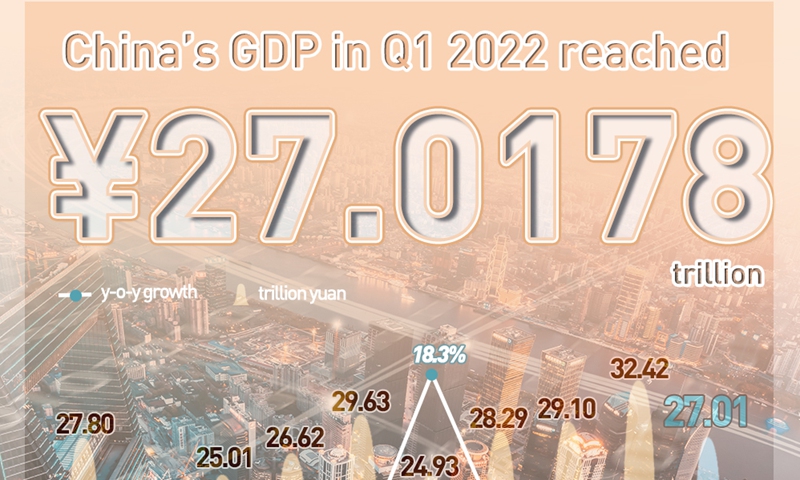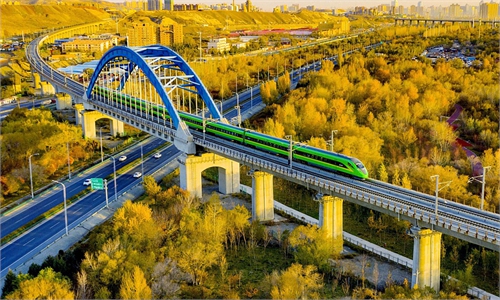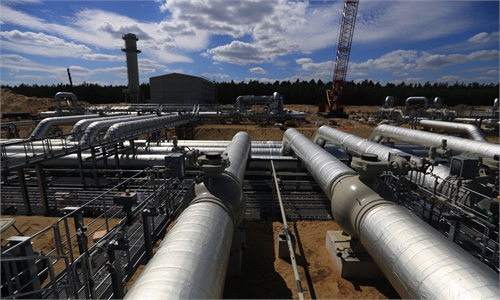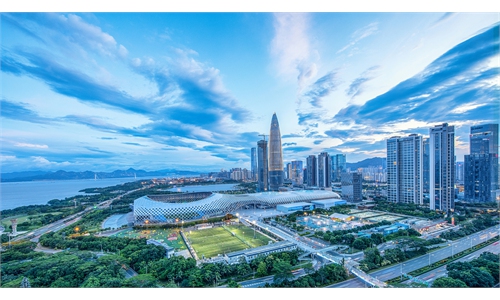China’s economy realizes stability despite unexpected changes: Global Times editorial

Graphic:Deng Zijun/GT
China's GDP grew by 4.8 percent in the first quarter of 2022, according to data released by the National Bureau of Statistics on Monday. Major media outlets across the world immediately reported the news. This figure was higher than the growth rate of 4 percent in the fourth quarter of 2021 and better than what the outside world expected. Against the backdrop of a difficult situation of the COVID-19 epidemic and the Russia-Ukraine conflict, except "geopolitical competition zealots," no one will not from the bottom of their hearts hope that a robust Chinese economy brings good news to the world in confusion and anxiety.It should be noted that the growth of 4.8 percent in the first quarter was hard-fought in the context of unexpected factors at home and abroad. The Russia-Ukraine conflict has wide-ranging implications, making the already unstable global industrial chain and supply chain even worse. With the conflict dragging on, the global economy may suffer from the double hit of slow growth and high inflation. This puts external pressure on China's economic development. In addition, the domestic epidemic also presents the characteristics of a wider affected region and more frequent occurrences, which makes China's economy more difficult to overcome obstacles.
In general, China's economic performance in the first quarter achieved stability at the beginning of 2022. Driven by a series of policies to stabilize growth, the main factors supporting economic growth, such as investment, consumption, industrial added value, and imports and exports, all rebounding strongly in the first two months, far exceeding expectations. From the perspective of the whole quarter, the overall performance of the "troika" was impressive: In terms of imports and exports, despite the contraction in global trade, China has maintained a growth rate of 10.7 percent; when it comes to investment, infrastructure construction increased by 8.5 percent in the first quarter, while this figure stood at 0.4 percent last year; although consumption has been affected by the epidemic since March and total retail sales of goods has been severely affected, it also achieved a growth of 3.3 percent, nearly double the 1.7 percent at the end of last year.
All these show that the Chinese economy's long-term positive fundamentals have not changed; the momentum of the sustained economic recovery has not changed and the characteristics of huge development potential, strong resilience and wide space have not changed. Against the sluggish global economy, China's economy on the whole has maintained strong resilience.
However, the outbreak of the COVID-19 epidemic since March has slowed the growth of some principal indexes. The downward pressure on the economy has increased, which deserves our attention. Uncertainties brought by the epidemic were the main factors impacting the economy. How to stabilize the economic situation and ease the downward pressure will become the crucial task for the second quarter. The key lies in whether we can put the epidemic under control as soon as possible and resume production and work - this will to a great extent determine the economic landscape in the second quarter and even the whole year. If the epidemic is effectively controlled in May, a continuous economic rebound in the second quarter is completely possible.
A national teleconference on efforts to keep supply and industrial chains stable was held in Beijing on Monday. The conference underscored the efforts to guarantee people's livelihood needs, freight transport, and business cycles. On the same day, the People's Bank of China and State Administration of Foreign Exchange issued a document about financial services on the epidemic prevention and control and socioeconomic development. The document puts forward 23 measures to support entities that are in difficulties, make smooth the economic circulation and promote foreign trade and exports. While taking resolute and decisive measures to contain the rebound of the epidemic in some areas, we should minimize the epidemic's impact on socioeconomic development. These are all pivots to the Chinese economy.
We also notice that some overseas media and institutions have been questioning China's strict epidemic fight as unsustainable with a high cost. But they don't perceive that China didn't choose to overdraft its future to exchange for today's well-being in the face of an unprecedented epidemic in a century. The dynamic zero-case policy is aimed at creating benign conditions for long-term healthy socioeconomic development at a short-term cost. China's epidemic fight has proven that short-term strict measures are aimed at bringing better opening. Dividing and antagonizing the epidemic fight and economic development while unfairly describing China's general economic situation using a particular situation reflect how the lens through which the West views China is losing focus again. If people take a longer perspective to look at the situation, they can easily find that China is the most stable among major economies.
"Stability" is the most prominent key word for China's economy in 2022. Under the influence of numerous uncertain factors, we need to face up to the difficulties, but also have faith and focus on doing our own things well. Pressure and challenges will deter the pessimists but will inspire those who advance bravely. Despite the noise, the initiative of China's economic development is always firmly held by the Chinese people who march forward with courage.



